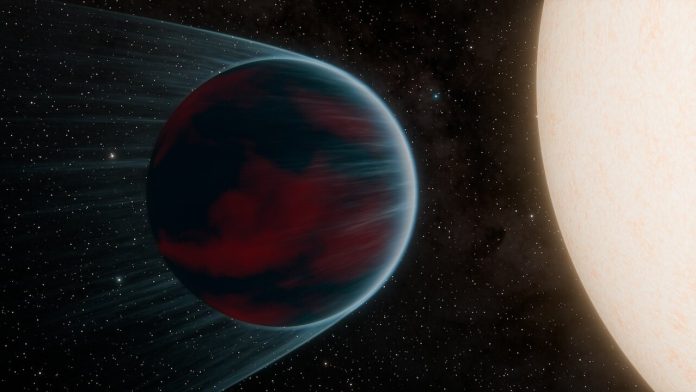
Astronomers have discovered a rare type of planet called a “hot Neptune.”
Named TOI-3261 b, this Neptune-sized planet is extremely close to its star, completing a full orbit in just 21 hours.
This makes it one of only four known “ultra-short-period hot Neptunes,” planets that are the size of Neptune but orbit their stars very closely.
The planet was discovered by an international team of scientists using NASA’s TESS space telescope.
They also observed it with ground-based telescopes in Australia, Chile, and South Africa.
The discovery places TOI-3261 b in what astronomers call the “hot Neptune desert,” a group of planets that are so rare they are compared to a deserted landscape.
TOI-3261 b is about the same size as Neptune, but it is much denser—about twice as dense.
This suggests its lighter atmospheric gases were stripped away over billions of years, leaving only the heavier parts of its atmosphere.
Scientists think the planet started out much larger, possibly the size of Jupiter. Over time, it lost its mass due to two main processes:
- Photoevaporation: Energy from the star caused gas particles in the planet’s atmosphere to escape into space.
- Tidal Stripping: The star’s strong gravitational pull stripped away layers of gas.
The planet may have originally formed farther from its star, where these effects are weaker, and then moved closer over time.
Astronomers estimate that the TOI-3261 system is about 6.5 billion years old. The dense, remaining atmosphere of TOI-3261 b makes it a perfect candidate for further studies.
Scientists plan to analyze its atmosphere in detail, possibly using NASA’s James Webb Space Telescope, which can detect the unique “fingerprints” of different molecules. These observations will help explain how planets like TOI-3261 b form and evolve.
The first ultra-short-period hot Neptune, LTT-9779 b, was found in 2020. Since then, two others—TOI-849 b and TOI-332 b—have joined this exclusive club. Like TOI-3261 b, these planets are being studied to learn more about their atmospheres and their unique evolution.
By studying TOI-3261 b, astronomers hope to unlock new secrets about how planets change when they are so close to their stars.
Source: NASA.



